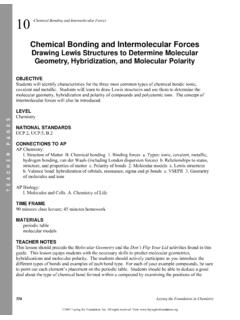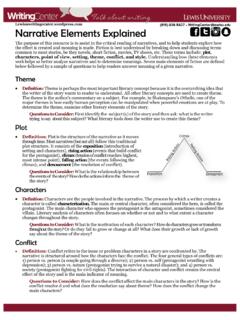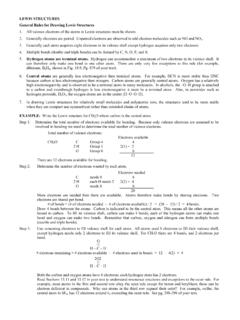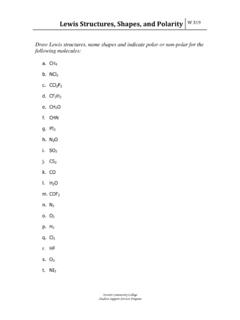Transcription of 3.4 Covalent Bonds and Lewis Structures - Columbia University
1 Bonds and LewisStructures In 1916 G. N. Lewis proposed that atomscombine in order to achieve a more stableelectron configuration. Maximum stability results when an atomis isoelectronic with a noble gas. An electron pair that is shared between two atoms constitutes a Covalent Lewis Model of ChemicalBondingCovalent Bondingin hydrogen atoms, each with 1 electron,Two hydrogen atoms, each with 1 electron,can share those electrons in a Covalent share those electrons in a Covalent ::HH Sharing the electron pair gives each hydrogen anelectron configuration analogous to Bondingin F2 Two fluorine atoms, each with 7 valence electrons,Two fluorine atoms, each with 7 valence electrons,can share those electrons in a Covalent share those electrons in a Covalent bond.
2 Sharing the electron pair gives each fluorinean electron configuration analogous to ::::..FF::FF::::..The Octet Rule The octet rule is the most useful in casesinvolving Covalent Bonds to C, N, O, and ::FF::::..In forming compounds, atoms gain, lose, orIn forming compounds, atoms gain, lose, orshare electrons to give a stable electronshare electrons to give a stable electronconfiguration characterized by 8 valenceconfiguration characterized by 8 ::..Combine carbon (4 valence electrons) andCombine carbon (4 valence electrons) andfourfour fluorines fluorines (7 valence electrons each)(7 valence electrons each)to write a Lewis structure for CFto write a Lewis structure for ::FF::..CC::FF::..::FF::..::FF::..The octet rule is satisfied for carbon and The octet rule is satisfied for carbon and each is common practice to represent a covalentIt is common practice to represent a covalentbond by a line.
3 We can rewritebond by a line. We can rewrite::FF::..CC::FF::..::FF::..::FF::. . ::::::::::::.. Bonds and Triple BondsInorganic examplesInorganic :::: ::::::::NN::CC::HH::NNCCHHC arbon dioxideCarbon dioxideHydrogen cyanideHydrogen cyanideOrganic examplesOrganic examplesEthyleneEthyleneAcetyleneAcetyle ne::::::CC::CC:: ::::.. Charges Formal charge is the charge calculatedfor an atom in a Lewis structure on thebasis of an equal sharing of bondedelectron ::..HHOOOOOONN::::.. We will calculate the formal charge foreach atom in this Lewis charge of HFormal charge of HNitric ::..HHOOOOOONN::::.. Hydrogen shares 2 electrons with oxygen. Assign 1 electron to H and 1 to O. A neutral hydrogen atom has 1 electron. Therefore, the formal charge of H in nitric acid charge of HFormal charge of HNitric.
4 HHOOOOOONN::::.. Oxygen has 4 electrons in Covalent Bonds . Assign 2 of these 4 electrons to O. Oxygen has 2 unshared pairs. Assign all 4 ofthese electrons to O. Therefore, the total number of electrons assignedto O is 2 + 4 = charge of OFormal charge of ONitric ::..HHOOOOOONN::::.. Electron count of O is 6. A neutral oxygen has 6 electrons. Therefore, the formal charge of O is charge of OFormal charge of ONitric ::..HHOOOOOONN::::.. Electron count of O is 6 (4 electrons fromunshared pairs + half of 4 bonded electrons). A neutral oxygen has 6 electrons. Therefore, the formal charge of O is charge of OFormal charge of ONitric ::..HHOOOOOONN::::.. Electron count of O is 7 (6 electrons fromunshared pairs + half of 2 bonded electrons).
5 A neutral oxygen has 6 electrons. Therefore, the formal charge of O is charge of OFormal charge of ONitric ::..HHOOOOOONN::::.. Electron count of N is 4 (half of 8 electronsin Covalent Bonds ). A neutral nitrogen has 5 electrons. Therefore, the formal charge of N is + charge of NFormal charge of N Nitric ::..HHOOOOOONN::::.. A Lewis structure is not complete unlessformal charges (if any) are chargesFormal charges ++Formal ChargeFormal ChargeFormal charge = Formal charge = group numbergroup numberin periodic tablein periodic tablenumber ofnumber ofbondsbondsnumber ofnumber ofunshared electronsunshared electrons An arithmetic formula for calculating formal arithmetic formula for calculating formal charge."Electron counts""Electron counts" and formal and formal charges in NHcharges in NH44+ + and BFand BF44-- 1144 NNHHHHHHHH++.
6 Lewis StructuresConstitution The order in which the atoms of amolecule are connected is called itsconstitution or connectivity. The constitution of a molecule mustbe determined in order to write aLewis structure. Step 1:The molecular formula and theconnectivity are determined How to Write LewisStructures Step 1:The molecular formula and theconnectivity are determined byexperiment. Example:Methyl nitrite has the molecularformula CH3NO2. All hydrogens arebonded to carbon, and the order ofatomic connections is How to Write LewisStructures Step 2:Count the number of valence a neutral molecule this is equal tothe number of valence electrons of theconstituent How to Write LewisStructures Step 2:Count the number of valence electrons.
7 Fora neutral molecule this is equal to thenumber of valence electrons of theconstituent atoms. Example (CH3NO2):Each hydrogen contributes 1 valenceelectron. Each carbon contributes 4,nitrogen 5, and each oxygen 6 for a total How to Write LewisStructures Step 3:Connect the atoms by a Covalent bondrepresented by a How to Write LewisStructures Step 3:Connect the atoms by a Covalent bondrepresented by a dash. Example:Methyl nitrite has the partial structure:Table How to Write LewisStructuresCCOONNOOHHHHHH Step 4:Subtract the number of electrons inbonds from the total number ofvalence How to Write LewisStructuresCCOONNOOHHHHHH Step 4:Subtract the number of electrons inbonds from the total number ofvalence electrons.
8 Example:24 valence electrons 12 electrons inbonds. Therefore, 12 more electronsto How to Write LewisStructures Step 5:Add electrons in pairs so that as manyatoms as possible have 8 with the most How to Write LewisStructures Step 5:Add electrons in pairs so that as many atoms aspossible have 8 electrons. Start with the mostelectronegative atom. Example:The remaining 12 electrons in methyl nitrite areadded as 6 How to Write ::.. Step 6:If an atom lacks an octet, use electron pairs on anadjacent atom to form a double or triple bond. Example:Nitrogen has only 6 electrons in the How to Write ::.. Step 6:If an atom lacks an octet, use electron pairs on anadjacent atom to form a double or triple bond.
9 Example:All the atoms have octets in this Lewis How to Write ::.. Step 7:Calculate formal charges. Example:None of the atoms possess a formal charge in thisLewis How to Write ::.. Step 7:Calculate formal charges. Example:This structure has formal charges; is less stableLewis How to Write Lewis ::..++ Condensed structural formulas Lewis Structures in which many (orall) Covalent Bonds and electronpairs are ::::HHcan be condensed to:can be condensed to:CHCH33 CHCHCHCH33 OHOH(CH(CH33)) IsomersConstitutional isomers Isomers are different compounds thathave the same molecular formula. Constitutional isomers are isomersthat differ in the order in which the atomsare connected. An older term for constitutionalisomers is structural isomers.
10 A Historical Note In 1823 Friedrich W hler discovered thatwhen ammonium cyanate was dissolved in hotwater, it was converted to urea. Ammonium cyanate and urea areconstitutional isomers of CH4N2O. Ammonium cyanate is inorganic. Urea is organic. W hler is credited with an importantearly contribution that helped overturn thetheory of vitalism. NHNH44 OCNOCNA mmoniumAmmonium cyanate cyanateHH22 NCNHNCNH22 OOUreaUreaNitromethaneNitromethaneMethyl nitriteMethyl ::HHCCOOOONN::::.. ++HHHHE xamples of constitutionalisomers Both have the molecular formula CH3NO2 but theatoms are connected in a different ::.. or more acceptable octet Lewis Structures may be written for certain compounds (or ions)Resonance Step 6:If an atom lacks an octet, use electron pairs on anadjacent atom to form a double or triple bond.
















